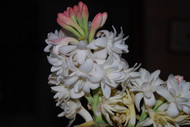Tuberose in India
Posted by Trygve Sahar Harris on 2nd Jan 2022
Tuberose in India
One summer, about 2006, I had the pleasure of visiting a Tuberose farm near Pune. Indian farm plots are quite small--this one was about an acre I think. Marigolds were planted along the edges, and interspersed with the tuberose.
Like asparagus, tuberose grows as a single long stalk; not on a bush or tree. There is no relation to Rose--the Latin binomial is Polianthus tuberosa whereas roses all belong to the Rosa ssp.
In India, tuberose flowers are primarily used in temples. In fact, about 80% of all flowers grown in India are on their way to be offered to the Gods. Tuberose, as well as Jasmine, Lotus, Champa, Gingerlily and of course Marigolds and many other flowers are offered to the priest inside the temple. He will take them and offer them in turn to the deity--whomever that may be, as temples are usually dedicated to one principal God and often there will be small shrines dedicated to other Gods inside. For example, a temple may be dedicated to the Mother Goddess in the form of Kali but inside there might be different shrines to worship Shiva, Ganesha, Hanuman, or other deities.
Once the priest has taken your offering of flowers (and often food,) you will receive more of the same back; this has already been blessed. It's now called Prasad and it's considered holy. You can nibble a little; share it with friends, strangers, cows, any other creature.
Of the remaining 20% of flowers, most of these go for weddings, which in India are large, lavish, and wild celebrations. A tiny percentage ends up on the street in the form of garlands for ladies to wear in their hair, and the remaining flowers wind up in extraction facilities, to be processed into concretes, absolutes, and similar products to feed India's ever increasing industrial and export capacities.
I love tuberose, although the flowers we occasionally find here in New York are quite sad in comparison, rarely opening and feebly fragranced. Tuberoses tend to like a Mediterranean climate, and pop up like freaks all over Mexico, Southern California, Egypt, and surrounding climates. However, they apparently take a plethora of water well, despite the dryness a Mediterranean climate implies. These pictures were taken at the end of the rainy season and one can see that the tuberoses are happy and plentiful. In fact, they are the first of the season's big fragrant flowers to come out.
Tuberose scent is very heady--it's a rich, heavy and voluptuous floral, fecund and aphrodisiac, startlingly sexual in its femininty, yet completely narcotic. Smelling a jar of Tuberose concrete will easily take your entire senses away--the taste of tuberose can immediately be felt in the back of the mouth. This flower, in its concentrated form, is not for the weak of spirit. But to a strong and passionate nature, tuberose, either alone, or in combination with other great florals, is a wonderful, powerful and erotic journey into desire.
This post originally appeared on the Absolute Trygve blog in 2006 and has been slightly edited for clarity.
© Trygve Sahar Harris 2006



